The Ultimate Men's Guide On How To Upgrade Your Look
2014.08.16
Anyone can gripe about wearing a suit; its an expensive item both to buy and maintain. But what if we told you that what you chose to wear is actually a physical representation of your current psychological state?
Clothing can affect us in many different ways; not just on how we look but also how we feel, how we think, and what others think of us. The last one shouldn't matter as much, but our society is still one built on first impressions. And the fact remains that every man instantly looks and feels amazing as soon as they put on a well-fitted suit.

Steve Jobs and Mark Zuckerberg might be renowned for their iconically casual style, but even they know that sometimes, you just need to suit up. Not only is it easier to look the part when you suit up, making the effort also makes them appear more composed, mature, and legitimate.

The fact remains that suited men just exude confidence, an attractive trait that is always sought out for. In that sense, wearing a suit is like having your foot in the doorway to all sorts of opportunities. And once your in, it becomes so much easier to sway them with your talents and skills.
For those of you who still need a little convincing, read up on the basics below on how to wear a suit to upgrade your appearance and confidence. By the time you reach the end of this post, you’ll stop asking “Why wear a suit?” and start looking for excuses to suit up.
Shirts & Ties
Matching a tie with a shirt might not exactly be rocket science, but it never hurts to be aware of your style options. Here's a quick guide on how to pull it off like a pro:
Solid-on-Solid
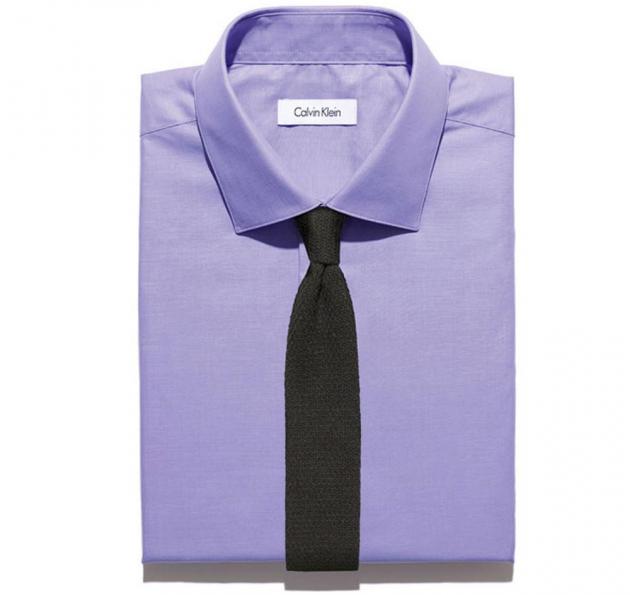
A classic, low-risk combo that involves pairing a solid tie with a solid shirt. Avoid wearing a color combination where the color in your respective shirt and tie combo are too close or that are the same exact color. Here are your options:
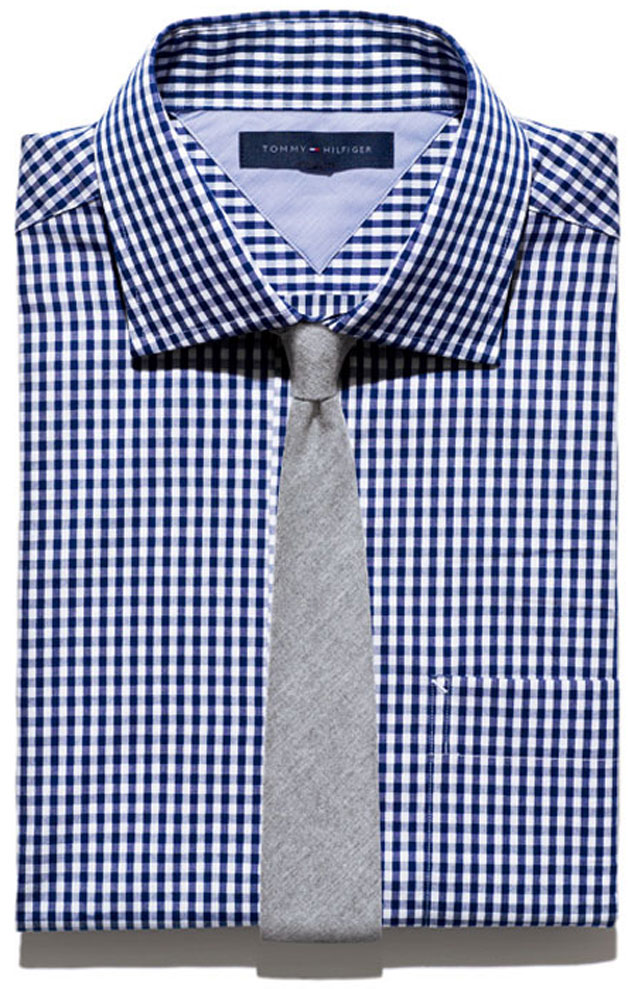
The key tip to pulling this off is to match the color of your solid tie with the color family of one (or more) of the colors in your patterned shirt.
Pattern-on-Solid
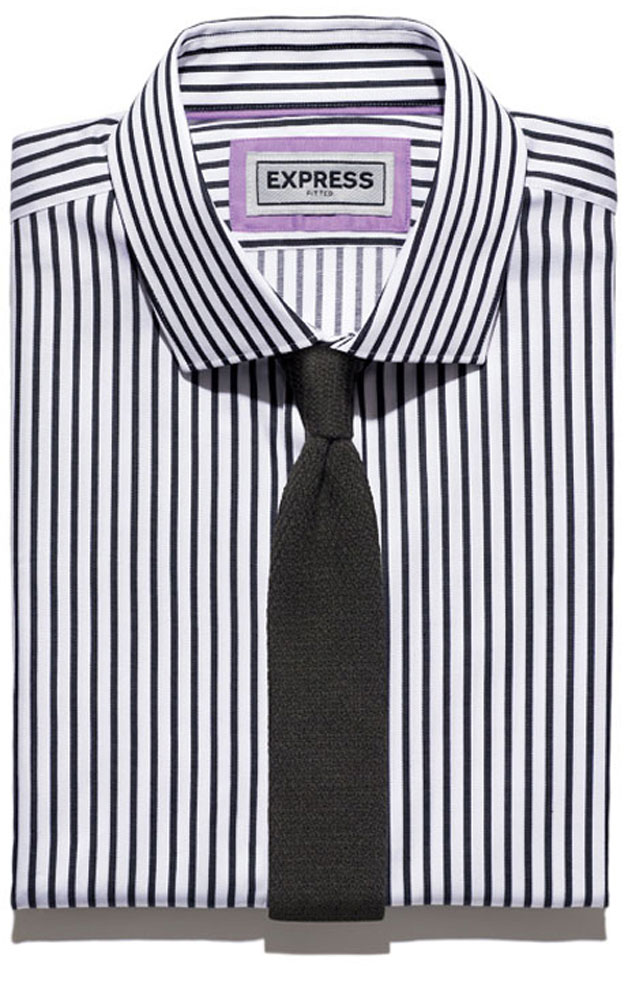
The trick here is to make sure that at least one or more of the colors within the pattern of the tie match with the color family of the solid shirt. To avoid looking like a fashion disaster, stick to these guidelines below:

Vary pattern type: Avoid having the same pattern appear in both your shirt and your tie. If your shirt has polka dots, don’t pair it with a dotted tie.
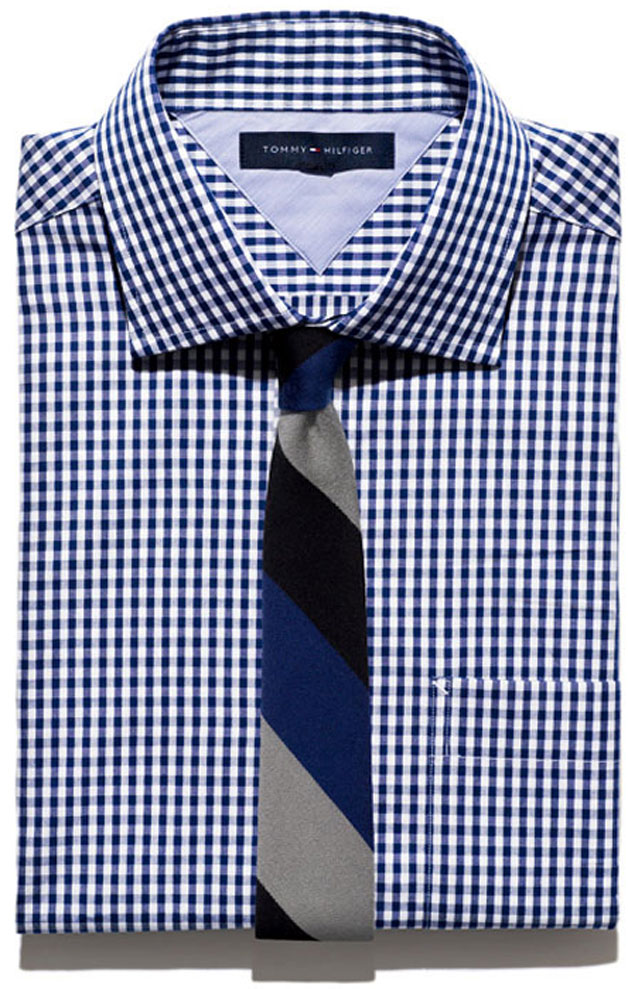
Vary pattern size/scale: The patterns on your tie should be larger and bolder than the patterns on your shirt. Having patterns of the same size/type can result in an overly busy look.
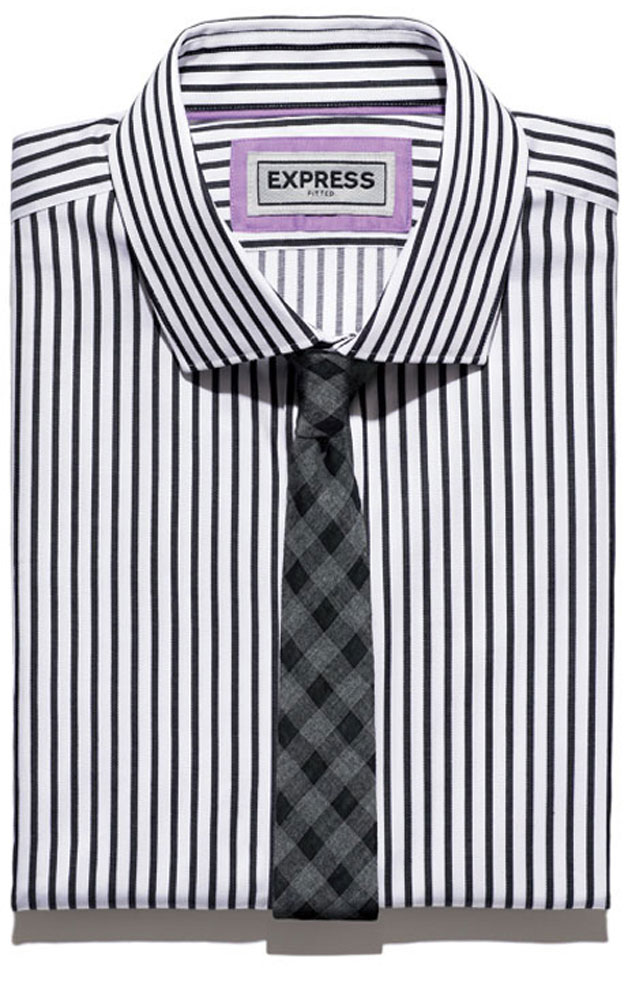
Match a detail in the tie with the dominant color of the shirt. Figure out the dominant color in your shirt and look for a tie with some of that color within the pattern.
Another important tie tips is to always match the widest point of your tie to the widest point of your suit lapel. This all has to do with proportions and will help you to achieve a more balanced look.
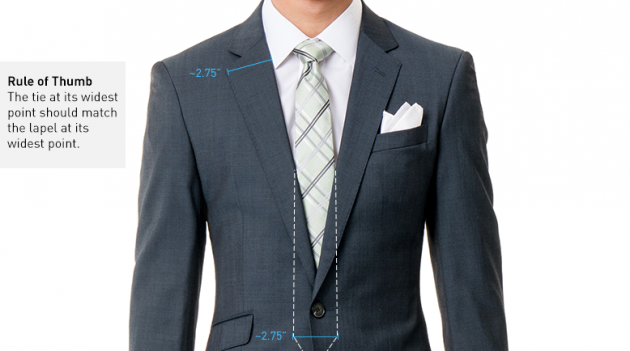
Besides the lapel width, you should also take into consideration things like your chest and shoulder size, the fit of your suit, shirt collar width, and your face shape.
Double-Breasted Suits
The double-breasted suit has been steadily been making a comeback, but don't raid your father's closet just yet.
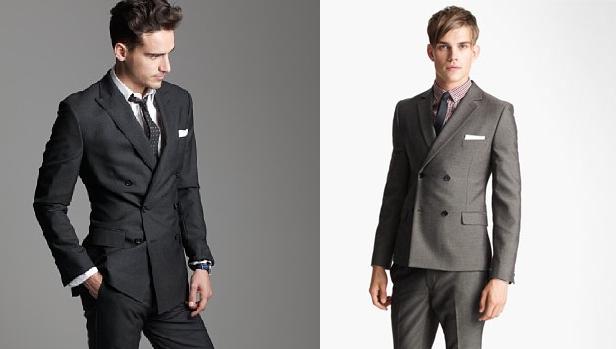
The modern DB suit jacket cuts much closer to the torso, comes with higher armholes, trimmer sleeves and natural shoulders without the extra bulk. Keep it sleek by paired ing with dressy pants (without pleats or cuffs)
When wearing one for dressier occasions (work, weddings, etc.), you can keep your shirt / tie combination relatively conservative with solid colors or basic patterns. If the occasion allows for it, you can add bold colors and patterns for your shirt, tie, pocket square and even socks.
If this is your first time wearing a double-breasted suit, stick to the "6×2" button configuration (top-left). Fasten the middle button while leaving the bottom button undone. Another popular double-breasted button configuration would be the "4×2" (top-right) which requires fastening only the top button.
Make sure to keep your DB suit buttoned while standing or sitting. All DB suits come with an "anchor button" located on the inside, which should be fastened at all times.
Go Casual With Suits
Whenever someone says that a man cleans up well, this usually means he only suits up for special occasions. But you shouldn’t really need a special occasion to "clean up" as there are a number of benefits you can get just by integrating a suit with your everyday wardrobe.
Here's a basic guideline on how to wear business suits during those days when you're feeling a little more casual:
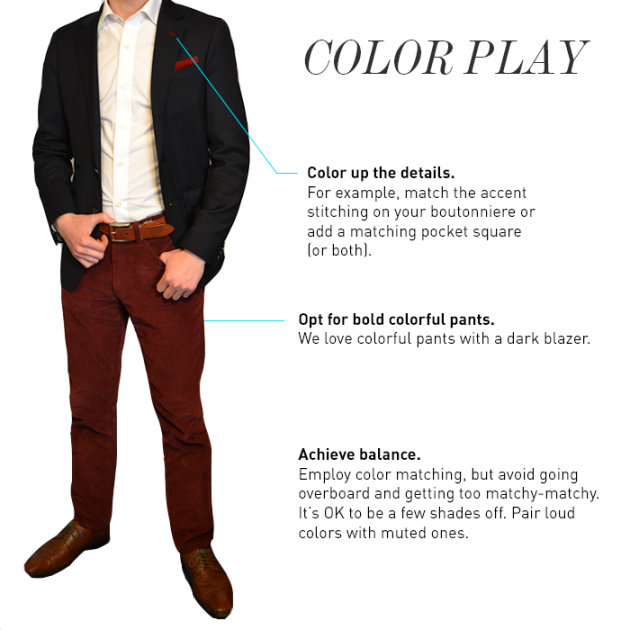
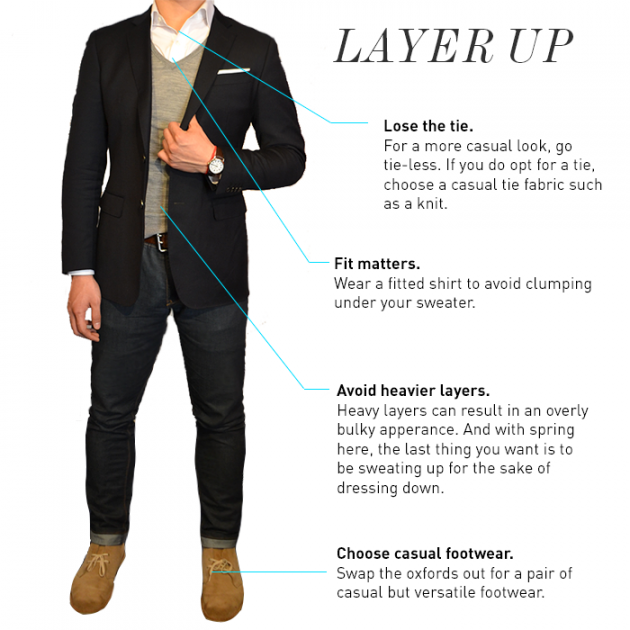
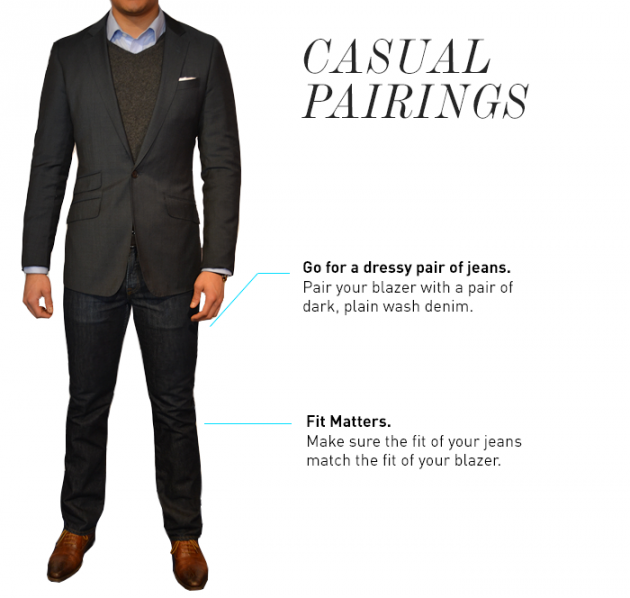
Wear A Vest
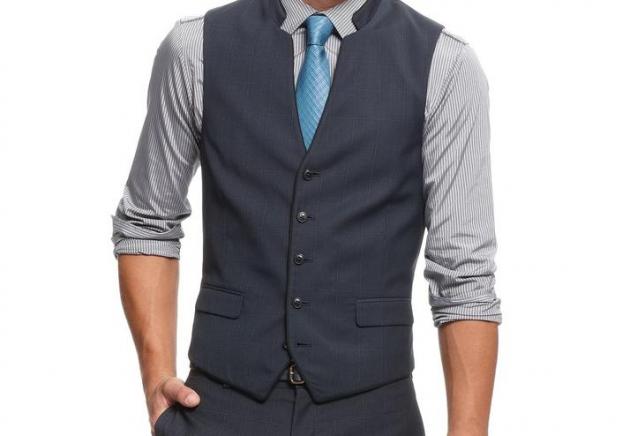
Another great casual look is to swap your usual t-shirt and cargo pants combo with a vest, a button-down shirt and some suit pants. Here's a guide on how to pick the right vest:

If you really can't live without your weekend denim fix, just pair your vest with dark wash jeans. Make sure the denim is a slimmer fit as it helps create a slimmer silhouette.
Clothing can affect us in many different ways; not just on how we look but also how we feel, how we think, and what others think of us. The last one shouldn't matter as much, but our society is still one built on first impressions. And the fact remains that every man instantly looks and feels amazing as soon as they put on a well-fitted suit.

Steve Jobs and Mark Zuckerberg might be renowned for their iconically casual style, but even they know that sometimes, you just need to suit up. Not only is it easier to look the part when you suit up, making the effort also makes them appear more composed, mature, and legitimate.

The fact remains that suited men just exude confidence, an attractive trait that is always sought out for. In that sense, wearing a suit is like having your foot in the doorway to all sorts of opportunities. And once your in, it becomes so much easier to sway them with your talents and skills.
For those of you who still need a little convincing, read up on the basics below on how to wear a suit to upgrade your appearance and confidence. By the time you reach the end of this post, you’ll stop asking “Why wear a suit?” and start looking for excuses to suit up.
Shirts & Ties
Matching a tie with a shirt might not exactly be rocket science, but it never hurts to be aware of your style options. Here's a quick guide on how to pull it off like a pro:
Solid-on-Solid

- Contrasting Color Combinations: If you want your outfit to "pop", try experimenting with colors. Example: Pair a solid white/light blue/pink with any color solid tie.
- Analogous Color Combinations: If you're looking for something with more of a sartorial sophistication, stick within the same color family. Example: Pair a solid light blue shirt with a solid dark blue tie, or a pink shirt with a red, maroon or purple tie.

Pattern-on-Solid




Another important tie tips is to always match the widest point of your tie to the widest point of your suit lapel. This all has to do with proportions and will help you to achieve a more balanced look.

Besides the lapel width, you should also take into consideration things like your chest and shoulder size, the fit of your suit, shirt collar width, and your face shape.
Double-Breasted Suits
The double-breasted suit has been steadily been making a comeback, but don't raid your father's closet just yet.

The modern DB suit jacket cuts much closer to the torso, comes with higher armholes, trimmer sleeves and natural shoulders without the extra bulk. Keep it sleek by paired ing with dressy pants (without pleats or cuffs)
When wearing one for dressier occasions (work, weddings, etc.), you can keep your shirt / tie combination relatively conservative with solid colors or basic patterns. If the occasion allows for it, you can add bold colors and patterns for your shirt, tie, pocket square and even socks.
If this is your first time wearing a double-breasted suit, stick to the "6×2" button configuration (top-left). Fasten the middle button while leaving the bottom button undone. Another popular double-breasted button configuration would be the "4×2" (top-right) which requires fastening only the top button.
Make sure to keep your DB suit buttoned while standing or sitting. All DB suits come with an "anchor button" located on the inside, which should be fastened at all times.
Go Casual With Suits
Whenever someone says that a man cleans up well, this usually means he only suits up for special occasions. But you shouldn’t really need a special occasion to "clean up" as there are a number of benefits you can get just by integrating a suit with your everyday wardrobe.
Here's a basic guideline on how to wear business suits during those days when you're feeling a little more casual:



Wear A Vest

Another great casual look is to swap your usual t-shirt and cargo pants combo with a vest, a button-down shirt and some suit pants. Here's a guide on how to pick the right vest:
- The sides should be snug on your torso and long enough to cover the belt halfway
- Always leave the last button unfastened (same goes for suit jackets)
- Ensure that the fabric of the shirt is not billowing out of the sides of the vest

If you really can't live without your weekend denim fix, just pair your vest with dark wash jeans. Make sure the denim is a slimmer fit as it helps create a slimmer silhouette.
More Articles
Copyright © Fooyoh.com All rights reserved.